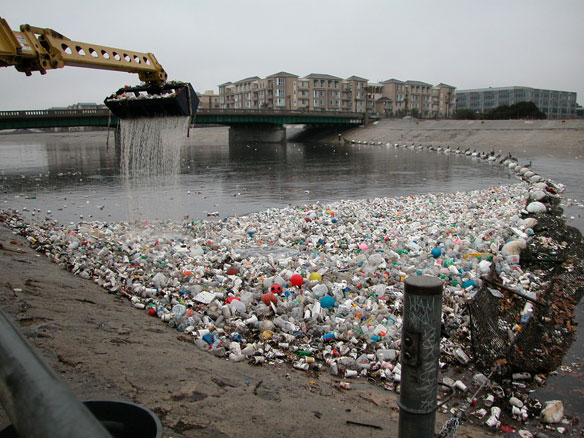“The problem of marine litter is a serious trans-boundary issue – eight million tonnes of plastic waste, from 192 countries that have a coastline, go into our oceans every year. India, with a 7,000-plus km coastline, has a role to play in controlling this menace,” said Sunita Narain, director general, Centre for Science and Environment (CSE), in her keynote address at a two-day national consultation workshop that ended in New Delhi on Wednesday, April 19, 2023.

A National Coalition of Coastal Cities, which will focus on combatting the scourge of marine litter across the country, was launched at the workshop, which was organised and spearheaded by CSE.
Global research estimates that about 80 per cent of marine litter comes from land-based mismanagement of solid waste that reaches the ocean bed through various land-to-sea pathways. The remaining 20 per cent is the contribution of coastal settlements.
About 90 per cent of all the waste that ends up in the marine ecosystem is plastics.
Out of 460 million tonnes (MT) of global plastic production, close to 353 MT comes back as plastic waste – 8 MT (2.26 per cent) of which is leaked into the marine ecosystem, as Narain pointed out.
Says Atin Biswas, programme director, solid waste management unit, CSE: “The extent of the litter in South Asian seas is a matter of particular concern. Estimates indicates that about 15,434 tonne of plastic waste is leaked into South Asian seas every day, accounting for a colossal 5.6 MT of plastic waste a year.”
CSE researchers point out that, in India, the estimated extent of marine litter is about 0.98 metric tonne of trash per km stretch of the coastline, with a concentration of 0.012 kg per square metre.
Says Siddharth G Singh, programme manager, solid waste management unit, CSE: “Tributaries of major Indian rivers are the pathways that carry around 15-20 per cent of plastic waste into the marine environment.”
India’s 7,517 km of coastline across nine states and 66 coastal districts, is home to about 250 million people. The coastline has 486 census towns and 36 class I towns. It also hosts 12 major and 185 minor ports. India is the world’s second largest fish producing nation, with about 2,50,000 fishing boats, 40,00,000 fisherfolk and 3,600 fishing villages. India’s coastline also has a rich biodiversity, protected by about 4,120 km of mangroves.
One of the key challenges worldwide is from Abandoned, Lost or Discarded Fishing Gear (ALDFG). A large part of ALDFG is lost in deep seas, making it difficult to recover. India has 174,000 units of fishing gear in operation, of which 154,008 units are gillnets/driftnets, 7,285 units are traps, and the rest are fishing lines. According to the Food and Agriculture Organisation (FAO), India loses 15,276 tonnes of gillnets annually.
Says Biswas: “In the year 2021, 58,000 kg of ghost net was recovered from the beaches and the ocean bed. The scale of the threat can be gauged from the fact that out of 1,000 eggs laid by a female turtle, only 10 are able to convert into adult turtles because of marine litter and ghost nets.”
One of the most common sources of marine litter is tourist and beach litter. A majority of these wastes is made up of multi-layered and low-value plastics, polystyrene, plastic products like cutlery and carry bags, cigarette butts, etc. These wastes are either not collected or are mismanaged, and eventually leak into the oceans through the stormwater drainage system, canals and small and big rivers. A large amount of footwear waste comprising of soles, synthetic bases and cloth bases are also being found in marine litter in India.
The other contributors to marine litter include fishing communities (mostly fishing gear), flood waters, discharge of untreated municipal sewage, automobile and industrial waste generated at the coasts and waste from shipbreaking yards.
Says Biswas: “Considering the complexity and scale of the problem, CSE felt the need to focus on marine litter as a matter of planning priority for local governments. Among the key problems that this national workshop has identified is an absence of adequate research-driven data; the lack of synergy in policy and practice among institutions connected to the causes of marine litter; and a need – as yet unmet — for investment in a communication strategy to engage with citizens, fishing communities and industrial establishments.
Adds Singh: “Since the problem has strong connections with the management of plastic waste on land, policies like the single-use plastic ban and EPR (extended producer responsibility) need to be enforced stringently.”
The CSE workshop was attended by representatives from state and city administrations from coastal states, marine research institutes, multi-lateral institutes working in India and other countries, NGOs working in the domain of marine litter, industry and technology solution providers, academicians, start-ups and individual practitioners and experts.
Says Biswas: “The outcome of these consultations will be used to form a coalition of coastal cities as a community and platform for further research, capacity building and advocacy in this subject.”
